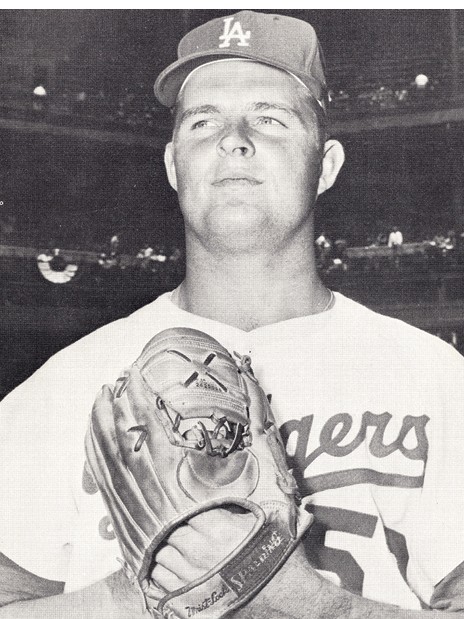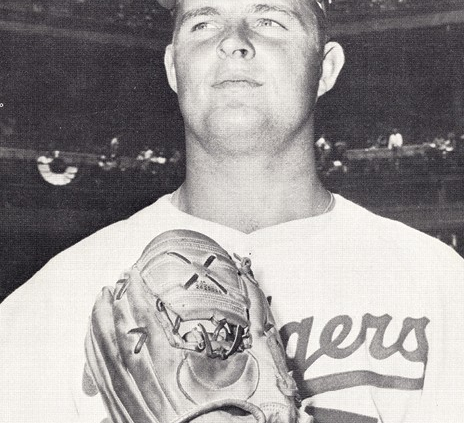June 8, 1968: Don Drysdale surpasses the Big Train for consecutive scoreless innings mark

Hall of Famer Don Drysdale won 209 games and hit 154 batters. He won the Cy Young Award in 1962. (SABR-Rucker Archive)
Los Angeles Dodgers pitcher Don Drysdale was known to inflict fear in batters. At 6-feet-5-inches tall, he was intimidating on the mound, unafraid to plunk a batter with one of his fastballs. He often used his baseball persona to his advantage, and it likely never came in handier than when he turned in one of the most dominating stretches by a pitcher – a consecutive scoreless innings streak that broke a long-standing record held by Hall of Famer Walter Johnson.
Drysdale was one of the last holdovers from the Dodgers team that moved from Brooklyn to the West Coast in 1958. He was in the majors in 1956 as a 19-year-old. He quickly became an innings-eater, a strikeout king, and an equally capable complement to another Dodgers fireballer, Sandy Koufax.
Drysdale developed a reputation as a brushback pitcher, in the style of notoriously intimidating pitchers like Sal Maglie and Early Wynn, who were in their prime in the 1950s.1 Drysdale, whose nickname was “Big D,” not only relied on an occasional brushback to move batters off the plate; he hit more batters (154) than any other major-league pitcher between 1956 and 1969. He was also suspected of using foreign substances to give himself an added advantage over batters.2
By 1968 Drysdale had been a Cy Young Award winner (1962), appeared in eight All-Star Games, and was a key contributor to three World Series championship teams (1959, 1963, and 1965). Still only 31 years old in his 13th season, he was no stranger to hurling shutouts. From 1956 to 1969 he led all major-league pitchers with 49 whitewashes. In the process of breaking Johnson’s 56-inning scoreless streak, set in 1913, he threw six straight shutouts, also a record. His streak became the crowning achievement in his Hall of Fame career.
Drysdale’s streak began on May 14 against the Chicago Cubs. Over the next 20 days, he threw five more shutouts, defeating Houston (twice), St. Louis, San Francisco, and Pittsburgh. Among the pitchers who opposed him were future Hall of Famers Ferguson Jenkins, Bob Gibson, and Jim Bunning. In all but one of the six games, he threw on three days’ rest.
In his autobiography Once a Bum, Always a Dodger, Drysdale recalled that he was the beneficiary of umpire Harry Wendlestedt’s favorable call in the game against the Giants. With the bases loaded in the ninth inning, Drysdale grazed Dick Dietz’s left elbow. That should have scored a run and ended his streak. But Wendlestedt ruled that Dietz made no effort to get out of the way of the pitch, thus negating the hit-by-pitch call. Drysdale ended up retiring Dietz and the next two Giants batters to preserve his streak.3
Along his historic journey, Drysdale passed several other pitchers with significant stretches of scoreless innings. One of them occurred earlier in the 1968 season when Cleveland Indians pitcher Luis Tiant recorded 41 shutout innings. Others Drysdale passed included Cy Young (45 innings in 1904), Doc White (45 in 1904), Sal Maglie (45 in 1950), Carl Hubbell (45⅓ in 1933), and Jack Coombs (53 in 1910).
The Phillies were in Los Angeles on Saturday, June 8, to play the Dodgers. A Ladies Night sellout crowd of 50,060 showed up at Dodger Stadium to witness Drysdale’s pursuit of Johnson’s record.4 Drysdale’s streak was at 54 innings, two behind Johnson.
Dodgers players wore black armbands on their left sleeves in memory of Senator Robert Kennedy, assassinated two days before at the Ambassador Hotel in Los Angeles while campaigning for the presidential nomination.5
Veteran right-hander Larry Jackson drew the starting assignment for Phillies manager Gene Mauch. The Phillies were in fourth place, 3½ games out of first place.
With his nerves perhaps getting the best of him, Drysdale had a shaky start in the first inning, throwing seven balls in his first eight pitches. But he regained his composure to keep his streak intact.6
In the second inning, Drysdale retired Bill White, Tony Taylor, and Clay Dalrymple, tying Johnson’s 55-year-old record.
In the top of the third, leadoff batter Roberto Peña hit a slow, high bouncer to third baseman Ken Boyer, who cleanly fielded the ball and carefully threw to first baseman Wes Parker for the out. With the record then broken, the jam-packed crowd let loose loud ovations for Drysdale’s accomplishment. Drysdale stood on the mound with his back to home plate and tried to soak in the moment. Later, when questioned about what he was thinking at the time, he said, “Thank God, it’s over with.”7
After the side was retired, plate umpire Augie Donatelli intercepted Drysdale on his way to the dugout. At the request of Mauch, the umpire asked Drysdale to remove his cap so he could check him for the use of foreign substances. He ran his fingers through Drysdale’s hair and confirmed Mauch’s suspicion. He ordered Drysdale to stop using the greasy substance. Then before the start of the fourth inning, Donatelli confronted him again on the mound and told him not to touch the back of his head or under the bill of his cap, or he would face automatic ejection. The Los Angeles Times surmised that Mauch was well aware of Drysdale’s pursuit of the innings record and waited until after he passed the milestone before registering his complaint with Donatelli.8
The Dodgers had taken a 1-0 lead in the first inning, when Boyer singled to score Willie Davis. In the bottom of the fourth Tom Haller doubled and Boyer singled. The combination of a fielder’s choice, a Phillies error, and a sacrifice fly added three more Dodger runs.
The Phillies started the fifth inning with singles by Taylor and Dalrymple. Peña struck out, but not before Drysdale caused him to hit the dirt. Howie Bedell, who played his first game with the Phillies two days earlier after not having appeared in the majors since 1962, pinch-hit for Jackson.9 Bedell stroked a fly ball to left field that scored Taylor from third, ending Drysdale’s streak at 58⅔ innings.
Drysdale gave up a solo home run to White in the sixth inning. After an RBI single by Cookie Rojas in the seventh made the score 4-3 and left runners on second and third, Dodgers manager Walter Alston pulled Drysdale. Reliever Hank Aguirre rescued the Dodgers by retiring the next two batters. The final run of the game came on Parker’s solo home run off Turk Farrell in the seventh inning. The final score was 5-3.
Drysdale was credited with his eighth win of the season. The Dodgers’ win was their ninth in their past 10 games. They were in second place, 2½ games behind the first-place St. Louis Cardinals. Jackson gave up four runs in four innings and took the loss to run his record to 6-6.
After retiring to the clubhouse, Drysdale admitted that it had been a harrowing experience throughout the stretch. He said breaking the streak “was bound to happen sooner or later.” He acknowledged he and his family had been disturbed by the death of Robert Kennedy, a family friend. He added, “This was just one of those nights, the kind when you just run out of steam.”10
Johnson pitched for the Washington Senators from 1907 to 1927. There were similarities between the former and new record-holders. Both had made their major-league debuts at age 19. Both had reputations for being menacing pitchers, mainly relying on their intimidating fastball. Johnson was a side-arm pitcher, while Drysdale frequently mixed in side-arm deliveries in his repertoire. At the time of Drysdale’s retirement, Johnson was the all-time leader in strikeouts (3,509). Drysdale was eighth on the list (2,486).
Partially overlapping Drysdale’s streak was another one involving the St. Louis Cardinals’ Bob Gibson. From June 2 to June 26, Gibson pitched 47 consecutive scoreless innings, in the midst of a 15-game winning streak. Gibson won both the Cy Young Award and Most Valuable Player Award that season.
Drysdale finished the season with a 14-12 record, as the Dodgers ended up in seventh place. Suffering from shoulder problems that had bothered him in earlier seasons, he retired late in the 1969 season at the age of 33 after making only 12 appearances. He was elected to the National Baseball Hall of Fame in 1984.
Dodgers pitcher Orel Hershiser broke Drysdale’s mark in 1988. He pitched 59 consecutive scoreless innings, composed of the last four innings of a game on August 30, five shutouts, and 10 shutout innings on September 28.
Sources
Lewis, Allen. “Dodgers Beat Phils; Drysdale Breaks Mark,” Philadelphia Inquirer, June 9, 1968: Section 3, 1.
Daley, Arthur (New York Times Service). “Big Train: Fastest Moundsman of All,” Long Beach (California) Press-Telegram, June 9, 1968: S-1.
Schlossberg, Dan. “Flashback: Orel Hershiser’s 1988 Season,” Baseball Digest, June 2003 (Vol. 62, No. 6): 48-51.
Notes
1 Joe Goddard, “Are Brushback Pitchers a Dying Breed?” Baseball Digest, September 1978: 43.
2 Emil Roth. “When Drysdale’s Shutout Streak Ended,” Baseball Digest, December 1973: 63.
3 Don Drysdale and Bob Verdi. Once a Bum, Always a Dodger (New York: St. Martin’s Press, 1990), 142.
4 The June 9, 1968, edition of the Los Angeles Times reported the total attendance as 55,017, with 50,060 as paid.
5 Dwight Chapin, “Boyer Carefully Handles Slow Hopper for Record,” Los Angeles Times, June 9, 1968: Section D, 1.
6 Dan Hafner, “Drysdale Sets Record (58⅔), Then Gets KO’d,” Los Angeles Times, June 9, 1968: Section D, 1.
7 Chapin, Section D, 6.
8 Chapin, Section D, 1.
9 Hafner.
10 Chapin, Section D, 1.
Additional Stats
Los Angeles Dodgers 5
Philadelphia Phillies 3
Dodger Stadium
Los Angeles, CA
Box Score + PBP:
Corrections? Additions?
If you can help us improve this game story, contact us.


